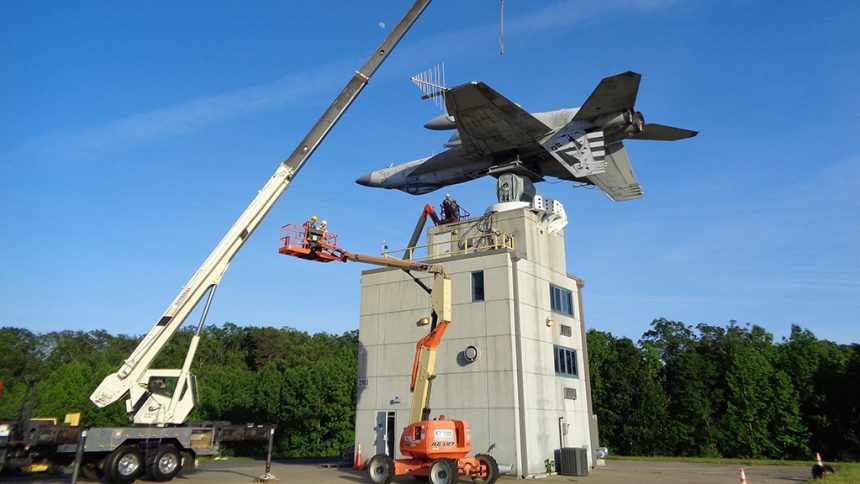First image showing Northrop Grumman’s full-up Next Generation Jammer-Low Band (NGJ-LB) Demonstration of Existing Technologies (DET) electronic warfare pod being tested.
On Jun. 22, 2020, Naval Air Systems Command (NAVAIR) Airborne Electronic Attack Systems Program Office (PMA-234) released the first image of the NGJ-LB pod on the belly (centerline) of a Super Hornet/Growler airframe [externally the two types are almost identical, the main difference is the presence, on the EA-18G, of the ALQ-218 electronics pods instead of the missile rails on the wingtips] being tested at the Facility for Antenna and Radar cross-section (RCS) Measurement at Naval Air Station Patuxent River, Maryland, in May/June 2020.
Interestingly, RCS isn’t a factor in these jammer pod tests. They’re looking at best/cleanest possible radiating performance from the antennas in the pod form factor. Pod was radiating outward, surrounding towers were receiving and measuring. So, although it was carried out in the RCS Measurement facility, it was not an RCS test.
As already reported in detail in an article we published at the beginning of the year, the NGJ (Next Generation Jammer) is a U.S. Navy program to augment, and ultimately replace the EA-18G Growler aircraft’s aging ALQ-99 TJS developed in the 1970s for the (retired) EA-6B Prowler.
The NGJ program aims to give the EA-18G fleet advanced airborne electronic attack capabilities through three frequency-focused increments – high-band, mid-band and low-band: in other words, the Growlers will replace the TJS pods operating in the 509 MHz to 18 GHz waveband, using three different pods, designated NGJ-LB (also known as Block/Increment 2), NGJ-MB (Capability Block/Increment 1), and NGJ-HB (Block/Increment 3) and directed specifically against the low- (100 MHz to 2 GHz waveband), mid- (2 GHz to 6 GHz), and high-band (6 GHz to 18 GHz) sections of the overall threat spectrum.
The first Engineering and Manufacturing Development (EMD) pod, a test article used to perform ground and aircraft integration testing, of the Next Generation Jammer Mid-Band (NGJ-MB) or Increment 1 pod was delivered by Raytheon to the U.S. Navy last August and has been mounted on an EA-18G Growler of the Air Test and Evaluation Squadron (VX) 23 Growler at Naval Air Station Patuxent River, Maryland, to start mission systems testing and qualification.
The pod is being used for both outdoor tests at the Facility for Antenna and Radar cross-section (RCS) Measurement (as shown in the photo) and at the indoor Air Combat Environmental Test and Evaluation Facility also located at Pax River.
While NGJ-MB will replace one of high-band ALQ-99 pods that Growlers carry under each wing, the NGJ-LB, will replace the low-band pod that the aircraft carry on the centerline store position under the fuselage (the third one, a high-band pod, being developed as part of the so-called Increment III, will be carried on the left wing). The NGJ-LB will be extremely important to provide cover to stealth aircraft, threatened by the emerging counter-stealth Low Band radars, engaging enemy threats from increased stand-off distances and employing increased capacity (number of jamming assignments).
Unlike the NGJ-MB pod, that uses two sets of door to allow ram air to enter and exit while emitting, based on the artist rendering Northrop Grumman has just released [that appears to be based on an actual photo (with some photo filter applied to it)], their NGJ-LB design will feature the typical front propeller of the RAT (Ram Air Turbine) as used in the ALQ-99 to generate power. Noteworthy, the new image of the centerline pod shows a slightly modified design than the original version that circulated last year, with the addition of what seems to be a small air intake on the upper rear section of the pod (whose shape is, for the rest, similar to the one of the ALQ-99).









